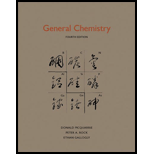
Concept explainers
Interpretation:
Empirical formula of compound when
Concept Introduction:
Mole is S.I. unit. The number of moles is calculated as ratio of mass of compound to molar mass of compound.
Molar mass is sum of the total mass in grams of all atoms that make up mole of particular molecule that is mass of 1 mole of compound. The S.I unit is
The expression to relate number of moles, mass and molar mass of compound is as follows:
Empirical formula represents simplest positive integer ratio of atoms in the compound. It only gives proportions of elements in compound. Molecular formula consists of
Answer to Problem 11.92P
Empirical formula of compound when
Explanation of Solution
The compound contains carbon, hydrogen oxygen and sulfur. Therefore, mass of carbon in carbon dioxide is equal to mass of carbon in the compound. Also, mass of hydrogen in water is equal to mass of hydrogen in compound.
The formula to calculate mass of
Substitute
The formula to calculate mass of
Substitute
The mass of sulfur in sulfur dioxide is equal to mass of sulfur in compound.
The formula to calculate mass of
Substitute
The formula to calculate mass
Substitute
The formula to calculate mass
Substitute
The formula to calculate mass
Substitute
The formula to calculate mass
Substitute,
Consider the sample to be
The formula to calculate number of moles of
Substitute
The formula to calculate number of moles of carbon is as follows:
Substitute
The formula to calculate number of moles of
Substitute
The formula to calculate number of moles of
Substitute
Preliminary formula for compound is formed with moles of
Each of subscript of
Want to see more full solutions like this?
Chapter 11 Solutions
General Chemistry
 ChemistryChemistryISBN:9781305957404Author:Steven S. Zumdahl, Susan A. Zumdahl, Donald J. DeCostePublisher:Cengage Learning
ChemistryChemistryISBN:9781305957404Author:Steven S. Zumdahl, Susan A. Zumdahl, Donald J. DeCostePublisher:Cengage Learning ChemistryChemistryISBN:9781259911156Author:Raymond Chang Dr., Jason Overby ProfessorPublisher:McGraw-Hill Education
ChemistryChemistryISBN:9781259911156Author:Raymond Chang Dr., Jason Overby ProfessorPublisher:McGraw-Hill Education Principles of Instrumental AnalysisChemistryISBN:9781305577213Author:Douglas A. Skoog, F. James Holler, Stanley R. CrouchPublisher:Cengage Learning
Principles of Instrumental AnalysisChemistryISBN:9781305577213Author:Douglas A. Skoog, F. James Holler, Stanley R. CrouchPublisher:Cengage Learning Organic ChemistryChemistryISBN:9780078021558Author:Janice Gorzynski Smith Dr.Publisher:McGraw-Hill Education
Organic ChemistryChemistryISBN:9780078021558Author:Janice Gorzynski Smith Dr.Publisher:McGraw-Hill Education Chemistry: Principles and ReactionsChemistryISBN:9781305079373Author:William L. Masterton, Cecile N. HurleyPublisher:Cengage Learning
Chemistry: Principles and ReactionsChemistryISBN:9781305079373Author:William L. Masterton, Cecile N. HurleyPublisher:Cengage Learning Elementary Principles of Chemical Processes, Bind...ChemistryISBN:9781118431221Author:Richard M. Felder, Ronald W. Rousseau, Lisa G. BullardPublisher:WILEY
Elementary Principles of Chemical Processes, Bind...ChemistryISBN:9781118431221Author:Richard M. Felder, Ronald W. Rousseau, Lisa G. BullardPublisher:WILEY





